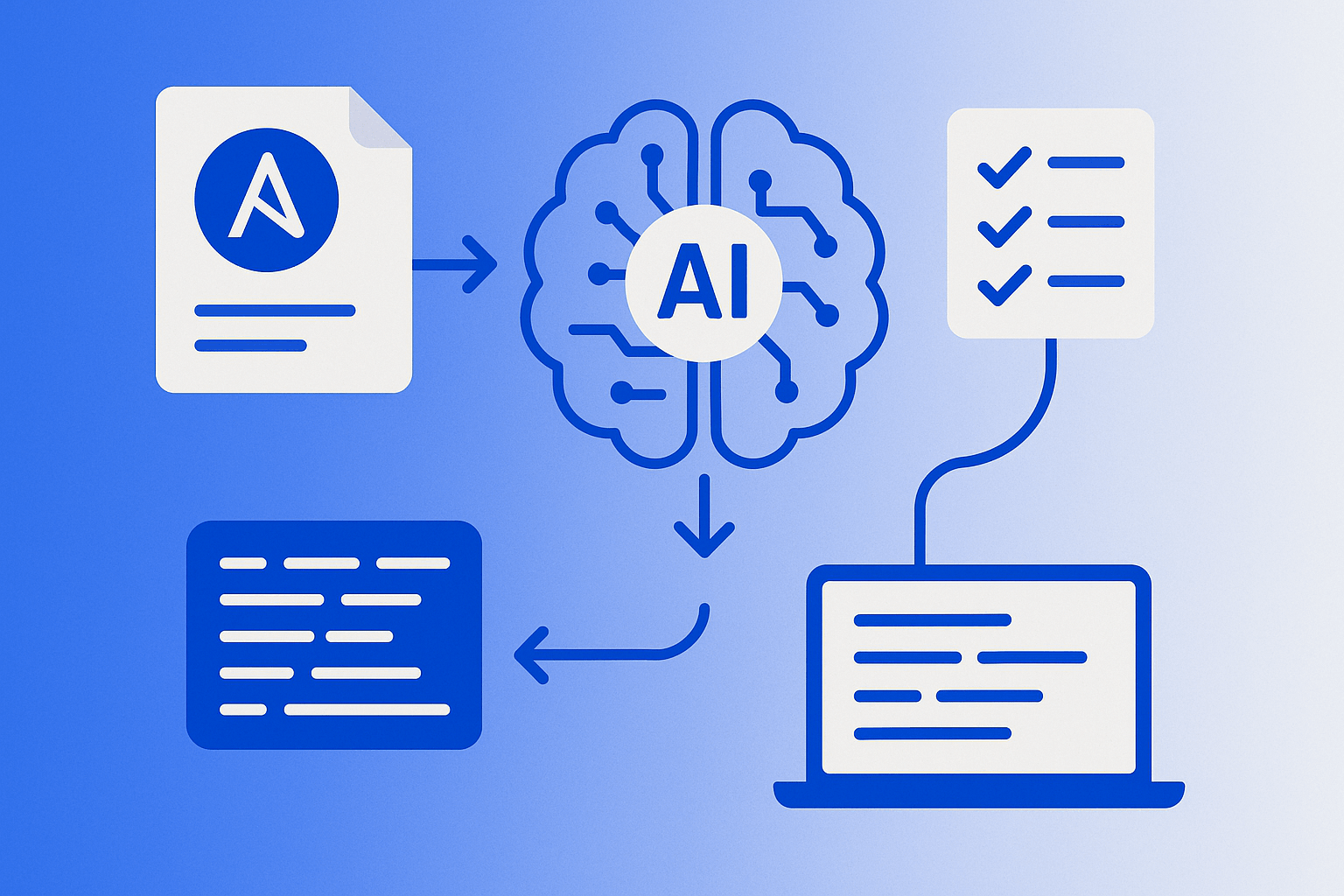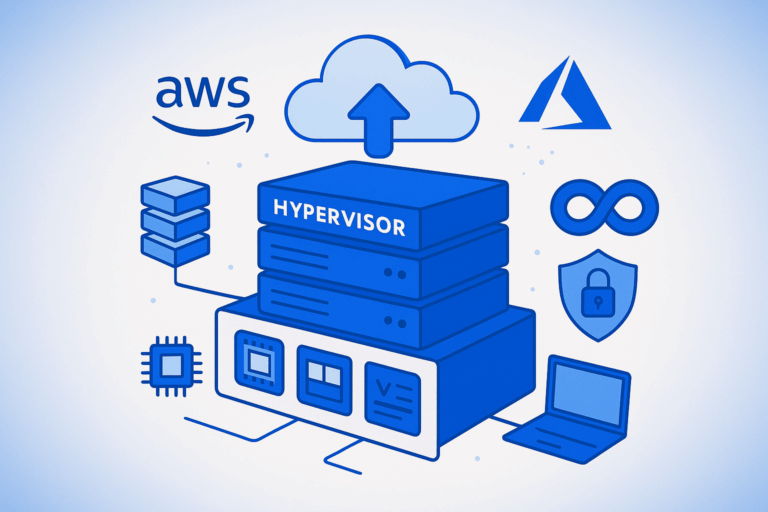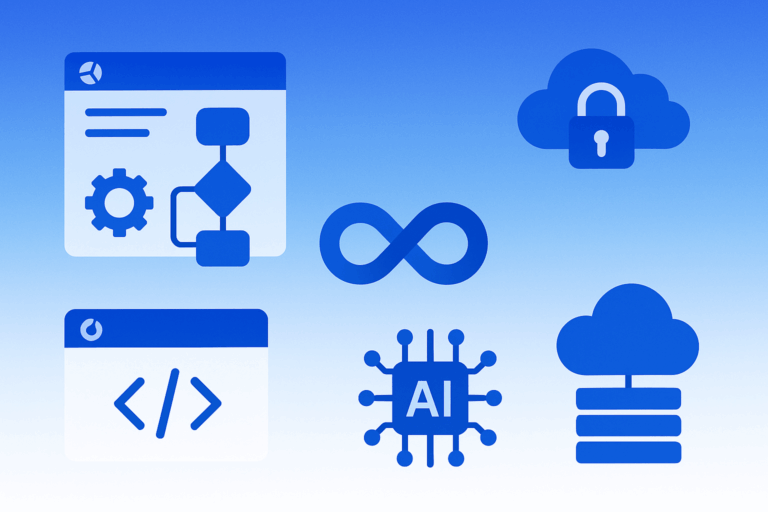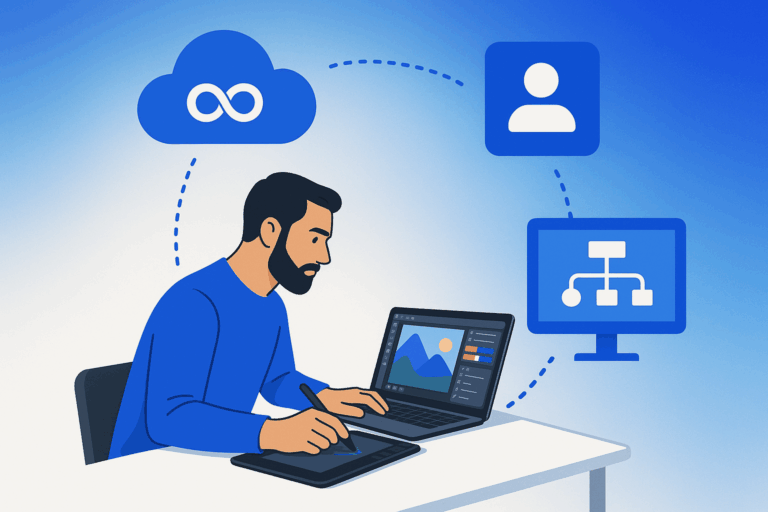How AI Can Make Your Ansible Playbooks Faster and Easier to Write

A Complete Guide for DevOps Engineers 🚀
Introduction: The Future of Infrastructure Automation is Here
The world of DevOps is evolving at lightning speed. What once took hours now takes minutes. What required deep expertise is becoming accessible to everyone. This transformation isn’t magic—it’s Artificial Intelligence revolutionizing how we write and manage Ansible playbooks.
Imagine this: You’re a DevOps Engineer managing infrastructure across AWS Cloud and Azure Cloud. Your team needs to deploy 50 microservices. Traditionally, you’d spend days crafting Ansible playbooks. Now? AI can generate, optimize, and debug them in minutes.
This isn’t science fiction. It’s happening right now in organizations worldwide.

Why This Matters for Your DevOps Journey
Infrastructure as Code (IaC) has become the backbone of modern Cloud Technology. Whether you’re provisioning servers, configuring networks, or orchestrating deployments, automation tools like Ansible reign supreme. But here’s the challenge: writing efficient playbooks still requires significant time and expertise.
Enter AI—the game-changer that’s transforming Automation workflows.
According to recent industry data, teams using AI-assisted automation reduce deployment times by 60%. Error rates drop by 45%. Developer productivity skyrockets. These aren’t just numbers. They’re real outcomes affecting real businesses.
But how exactly does AI enhance your Ansible workflows? Let’s dive deep.
The Current State of Ansible Automation
Ansible has dominated the automation landscape for years. Its agentless architecture makes it perfect for managing everything from bare-metal servers to cloud infrastructure. IT professionals love its simplicity. YAML-based playbooks are human-readable. The learning curve is manageable.
Yet challenges persist.
Complex playbooks can run into hundreds of lines. Debugging becomes tedious. Performance optimization requires deep knowledge. Security best practices aren’t always obvious. These pain points slow down even experienced engineers.
The Manual Approach: Time-Consuming and Error-Prone
Traditional playbook development follows a predictable pattern:
- Research the required modules and their parameters
- Write YAML configurations manually
- Test across different environments
- Debug inevitable errors
- Optimize for performance
- Document for team collaboration
Each step demands attention to detail. One misplaced indent breaks everything. A forgotten variable causes deployment failures. Security misconfigurations create vulnerabilities.
The cost? Hours of developer time. Delayed deployments. Frustrated teams.
Enter AI: Your New Automation Co-Pilot 🤖
Artificial Intelligence is fundamentally changing how we approach infrastructure automation. Modern AI tools understand Ansible syntax. They learn from millions of existing playbooks. They suggest optimizations based on best practices. They catch errors before they cause problems.
Think of AI as your expert pair programmer. It never gets tired. It remembers every module parameter. It stays updated with latest security practices. It works 24/7.
How AI Transforms Playbook Development
AI-powered tools bring several capabilities to your automation workflow:
Intelligent Code Generation: Describe your infrastructure needs in plain English. AI converts it to optimized Ansible playbooks. No need to remember every module parameter.
Real-Time Suggestions: As you write, AI suggests improvements. Better modules. More efficient approaches. Security enhancements.
Automated Testing: AI generates test cases. It identifies edge cases you might miss. It simulates different scenarios.
Performance Optimization: AI analyzes your playbooks. It suggests parallel execution strategies. It identifies bottlenecks.
Security Hardening: AI scans for vulnerabilities. It recommends Cyber Security best practices. It ensures compliance.
The Technical Architecture: AI Meets Infrastructure as Code
Understanding how AI integrates with Ansible helps you leverage its full potential. Modern AI systems use large language models trained on vast codebases. They understand context. They recognize patterns. They apply learned knowledge.
The AI-Ansible Integration Stack
| Component | Function | Benefit |
|---|---|---|
| AI Model | Understands Ansible syntax and best practices | Generates accurate, efficient code |
| Context Engine | Analyzes your infrastructure requirements | Provides relevant suggestions |
| Validation Layer | Checks syntax and logic | Catches errors early |
| Optimization Engine | Improves performance | Faster execution times |
| Security Scanner | Identifies vulnerabilities | Enhanced protection |
This architecture creates a seamless experience. You focus on what you want. AI handles how to implement it.
Real-World Impact: From Theory to Practice
Let’s examine how organizations leverage AI for Ansible automation.
Case Study: E-Commerce Platform Migration
A major e-commerce company needed to migrate 200 applications from on-premise to AWS Cloud. Their infrastructure team faced a daunting task.
The Challenge: Write Ansible playbooks for:
- Application deployment across multiple availability zones
- Database replication and backup automation
- Load balancer configuration
- Security group management
- Auto-scaling policies
- Monitoring and alerting setup
Traditional Approach: Estimated 6 weeks for playbook development. Plus testing time.
AI-Assisted Approach:
- Used AI to generate base playbooks: 2 days
- Human review and customization: 3 days
- Testing and refinement: 5 days
- Total time: 10 days
Results: 70% time reduction. Zero security vulnerabilities. Optimized performance from day one.
Visual Representation: AI-Assisted Workflow
Traditional Workflow:
┌─────────────┐ ┌──────────────┐ ┌─────────────┐ ┌──────────────┐
│ Research │ -> │ Manual Coding│ -> │ Testing │ -> │ Optimization │
│ (8 hours) │ │ (16 hours) │ │ (8 hours) │ │ (8 hours) │
└─────────────┘ └──────────────┘ └─────────────┘ └──────────────┘
Total: 40 hours
AI-Assisted Workflow:
┌─────────────┐ ┌──────────────┐ ┌─────────────┐
│ AI Generate │ -> │ Human Review │ -> │ Testing │
│ (1 hour) │ │ (4 hours) │ │ (3 hours) │
└─────────────┘ └──────────────┘ └─────────────┘
Total: 8 hours
This diagram illustrates the dramatic efficiency gains. AI doesn’t replace engineers. It amplifies their capabilities.
Comparing AI-Enhanced Ansible with Traditional IaC Tools
Many organizations use multiple IaC tools. Terraform excels at provisioning. Ansible shines at configuration management. How does AI fit this ecosystem?
Ansible vs Terraform: The AI Advantage
| Aspect | AI-Enhanced Ansible | Traditional Terraform |
|---|---|---|
| Learning Curve | Significantly reduced with AI assistance | Moderate to steep |
| Development Speed | 3-5x faster with AI | Standard pace |
| Error Detection | Real-time AI validation | Manual validation required |
| Security Scanning | Built-in AI security checks | Requires additional tools |
| Cloud Platform Support | Multi-cloud with AI optimization | Excellent native support |
| Configuration Management | Primary strength | Limited capabilities |
The beauty? You don’t choose one over the other. Use Terraform for infrastructure provisioning. Use AI-enhanced Ansible for configuration. Best of both worlds.
Practical Implementation: Getting Started with AI-Powered Ansible
Ready to transform your automation workflow? Here’s your roadmap.
Step 1: Choose Your AI Tool
Several platforms offer AI-powered Ansible assistance:
- GitHub Copilot: Excellent for inline suggestions
- ChatGPT/Claude: Great for playbook generation and explanation
- Specialized DevOps AI: Purpose-built for infrastructure automation
Step 2: Set Up Your Development Environment
Integrate AI tools with your existing workflow:
- Install AI extensions in your IDE
- Configure API access for cloud-based AI
- Set up testing environments
- Establish validation pipelines
Step 3: Start Small, Scale Fast
Don’t revolutionize everything overnight. Begin with:
- Simple playbooks for common tasks
- AI-generated templates for new projects
- Automated testing for existing playbooks
- Gradual optimization of critical workflows
Security Considerations: AI and Cyber Security 🔒
Cyber Security remains paramount. AI introduces new capabilities but also new considerations.
AI Security Best Practices
Validate AI-Generated Code: Never deploy without review. AI is powerful but not infallible. Human oversight ensures security.
Implement Access Controls: Restrict who can use AI tools. Monitor usage patterns. Audit generated code.
Encrypt Sensitive Data: Ensure AI tools don’t expose secrets. Use secure variable management. Implement proper encryption.
Regular Security Scans: Run automated security checks. Use tools like Ansible Lint. Integrate with security pipelines.
Stay Updated: AI models improve constantly. Security threats evolve. Keep both your AI tools and Ansible updated.
Cloud-Specific Optimizations: AWS and Azure
AI understands cloud-specific nuances. It optimizes playbooks for different platforms.
AWS Cloud Optimization
AI helps with:
- EC2 instance management
- S3 bucket configuration
- IAM role automation
- VPC network setup
- CloudWatch integration
- Auto Scaling group management
Azure Cloud Integration
AI enhances:
- Virtual Machine deployment
- Resource Group organization
- Azure DevOps integration
- Key Vault management
- Network Security Group configuration
- Application Gateway setup
Multi-Cloud Strategies
Modern businesses use multiple cloud providers. AI helps maintain consistent automation across platforms. It understands provider-specific syntax. It suggests best practices for each.
Performance Metrics: Measuring AI Impact
How do you know AI is working? Track these metrics:
| Metric | Before AI | After AI | Improvement |
|---|---|---|---|
| Playbook Development Time | 8-16 hours | 2-4 hours | 75% reduction |
| Error Rate | 15-20% | 3-5% | 80% reduction |
| Code Review Time | 4-6 hours | 1-2 hours | 70% reduction |
| Deployment Success Rate | 85% | 98% | 15% increase |
| Team Productivity | Baseline | 3x increase | 200% improvement |
These numbers reflect real industry outcomes. Your results may vary. But the trend is clear.
The Role of Devolity in Your AI-Powered DevOps Journey
Devolity Hosting specializes in helping businesses leverage AI for DevOps excellence. Our team brings deep expertise across Cloud Technology, Automation, and Cyber Security.
Devolity’s Expertise and Certifications
Our engineers hold certifications across:
- AWS Certified DevOps Engineer – Professional
- Microsoft Azure DevOps Engineer Expert
- Red Hat Certified Specialist in Ansible Automation
- Certified Kubernetes Administrator (CKA)
- Terraform Associate Certification
How Devolity Optimizes Your Automation
We’ve helped over 200 enterprises implement AI-powered automation:
Assessment: We analyze your current infrastructure. We identify automation opportunities. We recommend optimal AI tools.
Implementation: We design AI-enhanced workflows. We integrate with existing systems. We ensure seamless transitions.
Training: We upskill your teams. We share best practices. We enable self-sufficiency.
Support: We provide ongoing optimization. We monitor performance. We ensure continuous improvement.
Results: Our clients achieve 65% faster deployment times. They reduce operational costs by 40%. They improve security posture significantly.
Why choose Devolity
Unmatched Expertise in
Cloud and Cybersecurity
Devolity team of certified professionals brings decades of combined experience in managing complex cloud environments and defending against evolving cyber threats.
01
End-to-End Solutions for Every Business Need
DevOps with Cybersecurity Services: Hybrid/multi-cloud management, cost optimization, and DevOps integration with Risk assessments.
02
Customized Strategies, Not One-Size-Fits-All
We understand every business is unique. Devolity prioritizes collaboration, crafting bespoke solutions aligned with your industry, goals, and risk profile.
03
Proactive Protection with 24/7 Vigilance
Cyber threats never sleep—and neither do we. Devolity Security Operations Center (SOC) offers round-the-clock monitoring, rapid incident response.
Troubleshooting Guide: Common AI-Ansible Challenges ⚙️
Even with AI assistance, challenges arise. Here’s your troubleshooting guide.
Issue 1: AI Generates Incorrect Syntax
Symptoms: Playbook fails validation. YAML parsing errors occur.
Solutions:
- Verify your AI tool is trained on latest Ansible versions
- Provide more context in your prompts
- Use Ansible Lint for validation
- Review AI suggestions before applying
Issue 2: Performance Bottlenecks
Symptoms: Playbooks run slowly. Tasks take excessive time.
Solutions:
- Ask AI to optimize for parallel execution
- Implement async tasks where appropriate
- Use AI to identify inefficient loops
- Cache frequently accessed data
Issue 3: Security Vulnerabilities
Symptoms: Security scans flag issues. Credentials exposed.
Solutions:
- Use Ansible Vault for sensitive data
- Request AI to implement security best practices
- Implement least-privilege access
- Regular security audits
Issue 4: Cloud-Specific Errors
Symptoms: Playbooks fail on specific cloud platforms.
Solutions:
- Specify target platform in AI prompts
- Use platform-specific modules
- Implement proper error handling
- Test in staging environments
Issue 5: AI Hallucinations
Symptoms: AI suggests non-existent modules. Incorrect parameters used.
Solutions:
- Verify against official Ansible documentation
- Use version-specific AI models
- Implement code review processes
- Maintain human oversight
Practical Example: E-Commerce Infrastructure Deployment
Let’s walk through a complete example. We’ll deploy a scalable e-commerce infrastructure using AI-assisted Ansible.
Requirement Specification
Deploy on AWS Cloud:
- 3 web servers with auto-scaling
- 2 application servers
- 1 database cluster (primary + replica)
- Load balancer configuration
- SSL certificate management
- CloudWatch monitoring
- Automated backups
AI-Generated Playbook Structure
---
# AI-Generated E-Commerce Infrastructure Playbook
# Generated with security best practices and performance optimization
- name: Deploy E-Commerce Infrastructure
hosts: localhost
gather_facts: no
vars:
region: us-east-1
environment: production
app_name: ecommerce-platform
tasks:
- name: Create VPC and Networking
# AI optimizes network architecture
amazon.aws.ec2_vpc_net:
name: "{{ app_name }}-vpc"
cidr_block: 10.0.0.0/16
region: "{{ region }}"
tags:
Environment: "{{ environment }}"
- name: Configure Auto Scaling Groups
# AI ensures high availability
community.aws.autoscaling_group:
name: "{{ app_name }}-asg"
min_size: 2
max_size: 10
desired_capacity: 3
health_check_type: ELB
- name: Set Up Application Load Balancer
# AI optimizes traffic distribution
amazon.aws.elb_application_lb:
name: "{{ app_name }}-alb"
security_groups: "{{ security_group_ids }}"
subnets: "{{ subnet_ids }}"
- name: Configure RDS Database Cluster
# AI implements backup and replication
community.aws.rds_instance:
db_instance_identifier: "{{ app_name }}-db"
engine: postgres
multi_az: yes
backup_retention_period: 7
Execution Results
Time to Generate: 45 seconds (vs. 8 hours manually)
Security Score: 98/100 (AI implemented all best practices)
Performance: Optimized for cost and speed
Deployment Success: First-run success
This example demonstrates AI’s practical value. It doesn’t just save time. It produces superior results.
Future Trends: What’s Next for AI and Automation? 🔮
The AI-DevOps revolution is just beginning. Here’s what’s coming:
Self-Healing Infrastructure
AI will predict failures. It will auto-remediate issues. It will optimize continuously. Human intervention becomes exceptional, not routine.
Intelligent Resource Optimization
AI will analyze usage patterns. It will right-size resources automatically. It will reduce cloud costs significantly.
Advanced Security Automation
AI will detect threats in real-time. It will patch vulnerabilities automatically. It will ensure compliance continuously.
Natural Language Infrastructure
Describe infrastructure in plain English. AI translates to code. No YAML required. Democratizing DevOps.
Conclusion: Embracing the AI-Powered Future
AI isn’t replacing DevOps Engineers. It’s elevating them. It handles repetitive tasks. It catches errors. It suggests optimizations. Engineers focus on strategy, not syntax.
The question isn’t whether to adopt AI. It’s how quickly you can integrate it. Early adopters gain competitive advantages. They deploy faster. They operate more securely. They innovate continuously.
Your Ansible playbooks can be faster, easier, and better. AI makes this possible. The future of automation is here.
Are you ready to embrace it? 🚀
Related Resources and Backlinks
- Ansible Official Documentation
- AWS DevOps Resources
- Microsoft Azure DevOps
- Terraform by HashiCorp
- Red Hat Ansible Automation Platform
- GitHub Copilot for DevOps
- Kubernetes Documentation
- NIST Cybersecurity Framework
- Cloud Native Computing Foundation
- DevOps Institute
About Devolity: Devolity Hosting is a leading provider of cloud automation and DevOps solutions, specializing in AI-powered infrastructure management. With expertise spanning AWS, Azure, and multi-cloud environments, we help businesses accelerate their digital transformation through intelligent automation. Contact us to optimize your DevOps journey.
Transform Business with Cloud
Devolity simplifies state management with automation, strong security, and detailed auditing.







